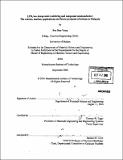| dc.contributor.advisor | Thomas W. Eagar. | en_US |
| dc.contributor.author | Yong, Foo Nun | en_US |
| dc.contributor.other | Massachusetts Institute of Technology. Dept. of Materials Science and Engineering. | en_US |
| dc.coverage.spatial | a-my--- | en_US |
| dc.date.accessioned | 2007-05-16T18:27:00Z | |
| dc.date.available | 2007-05-16T18:27:00Z | |
| dc.date.copyright | 2006 | en_US |
| dc.date.issued | 2006 | en_US |
| dc.identifier.uri | http://hdl.handle.net/1721.1/37376 | |
| dc.description | Thesis (M. Eng.)--Massachusetts Institute of Technology, Dept. of Materials Science and Engineering, 2006. | en_US |
| dc.description | Includes bibliographical references (leaves 88-89). | en_US |
| dc.description.abstract | Indium is a minor but very valuable metal. Decreasing supplies of indium from refining and increasing demands from LCD, low-temperature soldering and compound semiconductors have stimulated the indium price increase dramatically. Traditionally, indium is refined as a by-product of zinc refining. However, this type of indium extraction method is expected to last for the next 10-20 years and this opens a window to extract indium from other ores, especially from tin ore. Interestingly, extraction of indium from tin circuit can be considered as the major business and the pure tin metal is just considered as a by-product due to high indium price and low tin price. Relatively high estimated concentration levels of indium in Malaysian tin ore means that Malaysian tin refiners can withstand high degree of fluctuation of price in the free market due to hedge buying and speculation. Note that the business model for global indium market is duopoly or oligopoly but obviously not monopoly. Between duopoly and oligopoly, the most probable model is oligopoly. Thus, the potential competitors and partnership are also discussed here. Besides, LCD and low-temperature soldering and compound semiconductor are three main applications of indium which affect the indium price. | en_US |
| dc.description.abstract | (cont.) The unique properties of indium for three major applications will be discussed from the material engineering prospective. A cost modeling spreadsheet has been built to estimate the cost of production of indium from tin and zinc ores under different conditions. Hence, the decision tree has been drawn based on the conditions of different indium concentration level and price. From the discussions on the sources, market, applications of indium, the future prospects for indium can be concluded. The outcomes of this work can be extended to cases outside of the geographical boundary of Malaysia by gathering some relevant information. | en_US |
| dc.description.statementofresponsibility | by Foo Nun Yong. | en_US |
| dc.format.extent | 96 leaves | en_US |
| dc.language.iso | eng | en_US |
| dc.publisher | Massachusetts Institute of Technology | en_US |
| dc.rights | M.I.T. theses are protected by copyright. They may be viewed from this source for any purpose, but reproduction or distribution in any format is prohibited without written permission. See provided URL for inquiries about permission. | en_US |
| dc.rights.uri | http://dspace.mit.edu/handle/1721.1/7582 | |
| dc.subject | Materials Science and Engineering. | en_US |
| dc.title | LCD, low-temperature soldering and compound semiconductor : the sources, market, applications and future prospects of indium in Malaysia | en_US |
| dc.title.alternative | Liquid crystal display, low-temperature soldering and compound semiconductor : the sources, market, applications and future prospects of indium in Malaysia | en_US |
| dc.type | Thesis | en_US |
| dc.description.degree | M.Eng. | en_US |
| dc.contributor.department | Massachusetts Institute of Technology. Department of Materials Science and Engineering | |
| dc.identifier.oclc | 105289832 | en_US |
